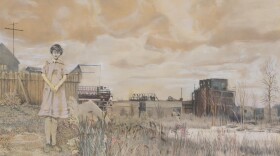http://stream.publicbroadcasting.net/production/mp3/michigan/local-michigan-944694.mp3
Art vs. ruin porn
Photographers from around the world parachute in to take pictures of Detroit’s crumbling, abandoned landscape. Some call it journalism or art; others call it ruin porn.
Dan Austin is obsessed with the abandoned buildings that litter the city's skyline. Turns out, he's not the only one:
"We have people email us all the time from France; we had someone last week email us from Sweden. They're like 'I want to come to Detroit and shoot photos of your architecture. Can you help me?'"
Austin posts historical information and pictures to his website, Buildings of Detroit. The website is now a book called Lost Detroit. Austin says he doesn't really have a problem with artists parachuting in to revel in the city's decay:
"Some think it's a negative, but on one hand anything that brings people to Detroit is a plus."
Austin says Michigan Central, the city's old train station, is the "undisputed champion of architectural ruin porn." You can see the massive building from the freeway: Windows busted out, spray paint everywhere, trees growing out from the top of the depot.
People sometimes compare it the Coliseum in Rome. It’s a giant ruin in the heart of a city. And almost every day people are there taking pictures.
Detroit Disassembled
New York photographer Andrew Moore photographed Michigan Central and dozens of other abandoned buildings in the city for his photo book Detroit Disassembled.
"I think there is a long artistic tradition of photographing ruin as a way of talking about man’s life and there’s a kind of mortality involved. Just as we look at an old face and see somebody’s life, you can look at an old building that’s certainly past its prime and get a sense of history. These places are witnesses to history, and an important history."
Moore spent 60 days in Detroit photographing all the ruin porn biggies in the city: The Packard Plant, the city’s old technical high school, the notorious Detroit Public Schools Book Depository, where thousands of books are moldering in piles on the floor.
Moore says being an outsider allows him to see the city differently:
"I think if you live there [Detroit], you’re so jaded to all this decay, dereliction, things falling apart, it’s hard to work from it. It’s hard to make art from it. So I think as a tourist, as somebody coming with fresh eyes, you have the advantage of a kind of horror and awe of this process and maybe even an enthusiasm."
Under the carcass lays the soul
Detroit photographers Roman Blanquart and Brian Widdis got so fed up a couple years ago with people parachuting in from all over the word to take pictures of the so called 'ruins' of Detroit they responded with their own website called Can’t Forget the Motor City. Blanquart says the idea for the project comes from an expression his wife uses: "Under the carcass lays the soul."
"That's what we want to explore, that soul. What do people do here? How do they live in this city that is bombed out in many ways, that is for many looks like a war zone?"
Their project focuses on people, not buildings. They capture what it’s like to walk through the neighborhoods: Mexican teens swinging on a park swing set, a pregnant couple embracing, a group of people dancing at John's Carpet House, a weekly summer blues jam in an abandoned lot.











